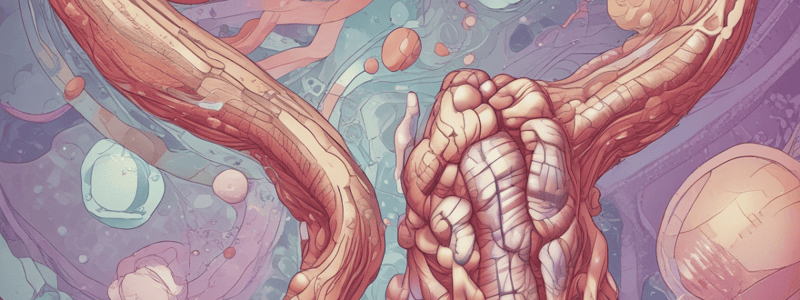Podcast
Questions and Answers
What is the effect of centrally acting muscle relaxants on voluntary power?
What is the effect of centrally acting muscle relaxants on voluntary power?
- Causes muscle paralysis
- Increases voluntary power
- Reduces voluntary power
- Does not reduce voluntary power (correct)
Which of the following is a characteristic of peripherally acting muscle relaxants?
Which of the following is a characteristic of peripherally acting muscle relaxants?
- Blocks neuromuscular transmission (correct)
- Is used in chronic spastic conditions
- Causes CNS depression
- Inhibits polysynaptic reflexes in the CNS
What is the mechanism of action of Thiocolchicoside?
What is the mechanism of action of Thiocolchicoside?
- Inhibits the release of excitatory amino acids
- Acts as a GABA mimetic (correct)
- Acts as a GABA antagonist
- Facilitates the release of excitatory amino acids
What is a common side effect of Tizanidine?
What is a common side effect of Tizanidine?
What is the primary use of Tizanidine?
What is the primary use of Tizanidine?
How is Tizanidine administered?
How is Tizanidine administered?
What is the mechanism of action of competitive blockers such as curare and related drugs?
What is the mechanism of action of competitive blockers such as curare and related drugs?
Which of the following is a centrally acting muscle relaxant?
Which of the following is a centrally acting muscle relaxant?
What is the primary difference between competitive and depolarizing blockers?
What is the primary difference between competitive and depolarizing blockers?
Which of the following is a peripherally acting non-depolarizing blocker?
Which of the following is a peripherally acting non-depolarizing blocker?
What is the primary effect of depolarizing blockers on muscle endplates?
What is the primary effect of depolarizing blockers on muscle endplates?
Which of the following is a centrally acting muscle relaxant with a mechanism of action involving GABA?
Which of the following is a centrally acting muscle relaxant with a mechanism of action involving GABA?
What is the primary method of treating tetanus using diazepam?
What is the primary method of treating tetanus using diazepam?
What is the primary use of centrally acting muscle relaxants in orthopaedic procedures?
What is the primary use of centrally acting muscle relaxants in orthopaedic procedures?
What is the primary benefit of using diazepam-like drugs in anxiety and tension-related muscle disorders?
What is the primary benefit of using diazepam-like drugs in anxiety and tension-related muscle disorders?
What type of muscle relaxants are commonly used to treat spastic neurological diseases?
What type of muscle relaxants are commonly used to treat spastic neurological diseases?
What is the primary benefit of combining muscle relaxants with analgesics in treating acute muscle spasms?
What is the primary benefit of combining muscle relaxants with analgesics in treating acute muscle spasms?
What is the primary application of diazepam in electroconvulsive therapy?
What is the primary application of diazepam in electroconvulsive therapy?
Flashcards are hidden until you start studying
Study Notes
Centrally Acting vs Peripherally Acting Muscle Relaxants
- Centrally acting muscle relaxants decrease muscle tone without reducing voluntary power, whereas peripherally acting ones cause muscle paralysis, resulting in loss of voluntary movements.
- Centrally acting muscle relaxants selectively inhibit polysynaptic reflexes in the CNS, whereas peripherally acting ones block neuromuscular transmission.
- Centrally acting muscle relaxants cause some CNS depression, whereas peripherally acting ones have no effect on the CNS.
- Centrally acting muscle relaxants are given orally or parenterally, whereas peripherally acting ones are practically always given intravenously.
- Centrally acting muscle relaxants are used in chronic spastic conditions, acute muscle spasms, and tetanus, whereas peripherally acting ones are used for short-term purposes, such as surgical operations.
Thiocolchicoside
- Thiocolchicoside is a GABA mimetic and glycinergic muscle relaxant.
- It is used in combination with NSAIDs for painful muscle spasms, sprains, torticollis, and backache.
Tizanidine
- Tizanidine is a central a2 adrenergic agonist that inhibits the release of excitatory amino acids in spinal interneurones.
- It facilitates the release of inhibitory transmitter glycine.
- It inhibits polysynaptic reflexes, reduces muscle tone, and frequency of muscle spasms without reducing muscle strength.
- It is used in spasticity due to neurological disorders and painful muscle spasms of spinal origin.
- Common side effects of tizanidine include dry mouth, drowsiness, night-time insomnia, hallucinations, and dose-dependent elevation of liver test values.
Classification of Skeletal Muscle Relaxants
- Skeletal muscle relaxants can be classified into two categories: peripherally acting and centrally acting.
- Peripherally acting muscle relaxants can be further classified into neuromuscular blocking agents, which include nondepolarizing blockers (long acting, intermediate acting, and short acting) and depolarizing blockers.
- Centrally acting muscle relaxants can be classified into directly acting agents, which include mephenesin congeners, dantrolene sodium, chlorzoxazone, GABA mimetic, and central a2 agonist.
Neuromuscular Blocking Agents
- Neuromuscular blocking agents act on the endplate of skeletal muscle fibers.
- Competitive blockers, such as curare, have affinity for the nicotinic (NM) cholinergic receptors at the muscle endplate but have no intrinsic activity.
- Depolarizing blockers, such as decamethonium and succinylcholine, have affinity and submaximal intrinsic activity at the NM cholinceptors, and initially produce twitching and fasciculations.
Uses of Skeletal Muscle Relaxants
- Acute muscle spasms, torticollis, lumbago, backache, and neuralgias respond to centrally acting muscle relaxants.
- Spastic neurological diseases, such as hemiplegia, paraplegia, spinal injuries, multiple sclerosis, and cerebral palsy, are treated with centrally acting muscle relaxants.
- Tetanus is treated with diazepam infusion.
- Electroconvulsive therapy and orthopedic manipulations may be performed under the influence of centrally acting muscle relaxants.
Studying That Suits You
Use AI to generate personalized quizzes and flashcards to suit your learning preferences.





